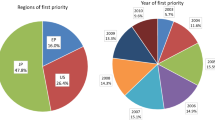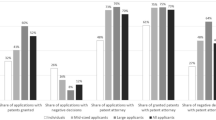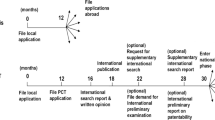Abstract
In this study, we investigate and compare the number of examiners’ forward citations in the United States and Japan. The most effective way to do so is to compare pairs of patent applications that have equivalent content. Therefore, we propose a new method of extracting substantially equivalent pairs of US and Japanese patent applications, focusing on the equivalence of the specifications and the claims. Our results reveal that during the substantive examination, US examiners cite patent application publications (PAPs) as well as granted patent publications (GPPs), whereas Japanese examiners tend to cite PAPs only. We further examine why GPPs are frequently cited by US examiners. The most likely reason seems to be that many US examiners retain the old habit of searching and citing only GPPs, but not PAPs. The insights offered by this study could be significant for future analyses based on the number of citations, particularly in the United States.




Similar content being viewed by others
Notes
Examiners in both the US and JP can cite any documents disclosed prior to the filing of the patent application in order to deny novelty or non-obviousness of patent applications during the substantive examination. This is based on 35 U.S.C. 102 and 103 in the US and Article 29 of the Patent Act in JP.
PAPs are published under this system. See point (a) in the subsection “The effects of differences in the US and JP patent systems” in the “Results and discussion” section for a brief explanation of the Pre-Grant Publication system.
This is the master documentation database of the European patent office.
The definition of the INPADOC patent family is available at http://www.epo.org/searching/essentials/patent-families/inpadoc.html.
In this study, we limited our analysis to the period after the introduction of the Pre-Grant Publication system in the US. Therefore, we limited US patent applications to those for which PAPs were published.
This discussion is based on the experiences of the corresponding author of this study, who worked in the Japan Patent Office as a patent examiner for almost 10 years.
See footnote 1.
This requirement is based on Article 17bis(3) of the Patent Act in Japan. The US has almost the same requirement, based on 35 U.S.C. 112 and 132.
This period was 7 years until august 2001.
See Chapter 2016 of the Manual of Patent Examining Procedure published in the US. (http://www.uspto.gov/web/offices/pac/mpep/mpep-2000.pdf).
References
Albert, M. B., Avery, D., Narin, F., & McAllister, P. (1991). Direct validation of citation counts as indicators of industrially important patents. Research Policy, 20, 251–259.
Alcácer, J., Gittelman, M., & Sampat, B. (2009). Applicant and examiner citations in US patents: An overview and analysis. Research Policy, 38, 415–427.
Carpenter, M. P., Narin, F., & Woolf, P. (1981). Citation rates to technologically important patents. World Patent Information, 3, 160–163.
Gambardella, A., Harhoff, D., & Verspagen, B. (2008). The value of European patents. European Management Review, 5, 69–84.
Goto, A., & Motohashi, K. (2007). Construction of a Japanese Patent Database and a first look at Japanese patenting activities. Research Policy, 36, 1431–1442.
Hall, B. H., Jaffe, A. B., & Trajtenberg, M. (2001). The NBER patent citation data file: Lessons, insights and methodological tools. NBER Working Paper, No. 8498.
Harhoff, D., Narin, F., Scherer, F. M., & Vopel, K. (1999). Citation frequency and the value of patented inventions. Review of Economics and Statistics, 81, 511–515.
Harhoff, D., Scherer, F. M., & Vopel, K. (2003). Citations, family size, opposition and the value of patent rights. Research Policy, 32, 1343–1363.
Hegde, D., & Sampat, B. (2009). Examiner citations, applicant citations, and the private value of patents. Economics Letters, 105, 287–289.
Lanjouw, J. O., & Schankerman, M. (2004). Patent quality and research productivity: Measuring innovation with multiple indicators. Economic Journal, 114, 441–465.
Martinez, C. (2011). Patent families: When do different definitions really matter? Scientometrics, 86, 39–63.
Meyer, M. (2000). What is special about patent citations? Differences between scientific and patent citations. Scientometrics, 49, 93–123.
Michel, J., & Bettels, B. (2001). Patent citation analysis: A closer look at the basic input data from patent search reports. Scientometrics, 51, 185–201.
Mogee, M. E. (2007). Comparison of US, EPO, and PCT patent citations for citation analysis. Science, Technology, and Innovation Policy, 2007 Atlanta Conference. doi:10.1109/ACSTIP.2007.4472902
Nagaoka, S., Motohashi, K., & Goto, A. (2010). Chapter 25: Patent statistics as an innovation indicator. Handbook of the economics of innovation, 2(2), 1083–1127.
Nagaoka, S., & Walsh, J. (2009). The R&D Process in the U.S. and Japan: Major findings from the RIETI-Georgia Tech inventor survey. RIETI Discussion Paper Series, 09-E-010.
Narin, F., & Olivastro, D. (1998). Linkage between patents and papers: An interim EPO/US comparison. Scientometrics, 41, 51–59.
OECD (2009). OECD Patent Statistics Manual. http://www.oecd.org/sti/inno/oecdpatentstatisticsmanual.htm. Accessed 24 Jan 2014.
Wada, T. (2009). Recognition of the prior patents by applicants and patent forward citation (in Japanese). RIETI Discussion Paper Series, 10-J-001.
WIPO (2013). IPC—Technology Concordance Table. http://www.wipo.int/ipstats/en/statistics/technology_concordance.html. Accessed 21 June 2014.
Yasukawa, S., & Kano, S. (2013). Validating the usefulness of examiners’ forward citations from the viewpoint of applicants’ self-selection during the patent application procedure. Scientometrics, 99, 895–909.
Author information
Authors and Affiliations
Corresponding author
Rights and permissions
About this article
Cite this article
Yasukawa, S., Kano, S. Comparison of examiners’ forward citations in the United States and Japan with pairs of equivalent patent applications. Scientometrics 102, 1189–1205 (2015). https://doi.org/10.1007/s11192-014-1466-5
Received:
Published:
Issue Date:
DOI: https://doi.org/10.1007/s11192-014-1466-5




